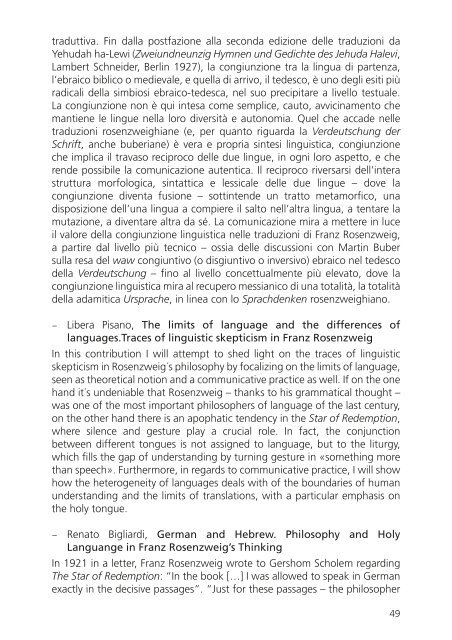Franz Rosenzweig
VZ2hG1
VZ2hG1
You also want an ePaper? Increase the reach of your titles
YUMPU automatically turns print PDFs into web optimized ePapers that Google loves.
traduttiva. Fin dalla postfazione alla seconda edizione delle traduzioni da<br />
Yehudah ha-Lewi (Zweiundneunzig Hymnen und Gedichte des Jehuda Halevi,<br />
Lambert Schneider, Berlin 1927), la congiunzione tra la lingua di partenza,<br />
l’ebraico biblico o medievale, e quella di arrivo, il tedesco, è uno degli esiti più<br />
radicali della simbiosi ebraico-tedesca, nel suo precipitare a livello testuale.<br />
La congiunzione non è qui intesa come semplice, cauto, avvicinamento che<br />
mantiene le lingue nella loro diversità e autonomia. Quel che accade nelle<br />
traduzioni rosenzweighiane (e, per quanto riguarda la Verdeutschung der<br />
Schrift, anche buberiane) è vera e propria sintesi linguistica, congiunzione<br />
che implica il travaso reciproco delle due lingue, in ogni loro aspetto, e che<br />
rende possibile la comunicazione autentica. Il reciproco riversarsi dell’intera<br />
struttura morfologica, sintattica e lessicale delle due lingue – dove la<br />
congiunzione diventa fusione – sottintende un tratto metamorfico, una<br />
disposizione dell’una lingua a compiere il salto nell’altra lingua, a tentare la<br />
mutazione, a diventare altra da sé. La comunicazione mira a mettere in luce<br />
il valore della congiunzione linguistica nelle traduzioni di <strong>Franz</strong> <strong>Rosenzweig</strong>,<br />
a partire dal livello più tecnico – ossia delle discussioni con Martin Buber<br />
sulla resa del waw congiuntivo (o disgiuntivo o inversivo) ebraico nel tedesco<br />
della Verdeutschung – fino al livello concettualmente più elevato, dove la<br />
congiunzione linguistica mira al recupero messianico di una totalità, la totalità<br />
della adamitica Ursprache, in linea con lo Sprachdenken rosenzweighiano.<br />
– Libera Pisano, The limits of language and the differences of<br />
languages.Traces of linguistic skepticism in <strong>Franz</strong> <strong>Rosenzweig</strong><br />
In this contribution I will attempt to shed light on the traces of linguistic<br />
skepticism in <strong>Rosenzweig</strong>´s philosophy by focalizing on the limits of language,<br />
seen as theoretical notion and a communicative practice as well. If on the one<br />
hand it´s undeniable that <strong>Rosenzweig</strong> – thanks to his grammatical thought –<br />
was one of the most important philosophers of language of the last century,<br />
on the other hand there is an apophatic tendency in the Star of Redemption,<br />
where silence and gesture play a crucial role. In fact, the conjunction<br />
between different tongues is not assigned to language, but to the liturgy,<br />
which fills the gap of understanding by turning gesture in «something more<br />
than speech». Furthermore, in regards to communicative practice, I will show<br />
how the heterogeneity of languages deals with of the boundaries of human<br />
understanding and the limits of translations, with a particular emphasis on<br />
the holy tongue.<br />
– Renato Bigliardi, German and Hebrew. Philosophy and Holy<br />
Languange in <strong>Franz</strong> <strong>Rosenzweig</strong>’s Thinking<br />
In 1921 in a letter, <strong>Franz</strong> <strong>Rosenzweig</strong> wrote to Gershom Scholem regarding<br />
The Star of Redemption: “In the book […] I was allowed to speak in German<br />
exactly in the decisive passages”. “Just for these passages – the philosopher<br />
49


